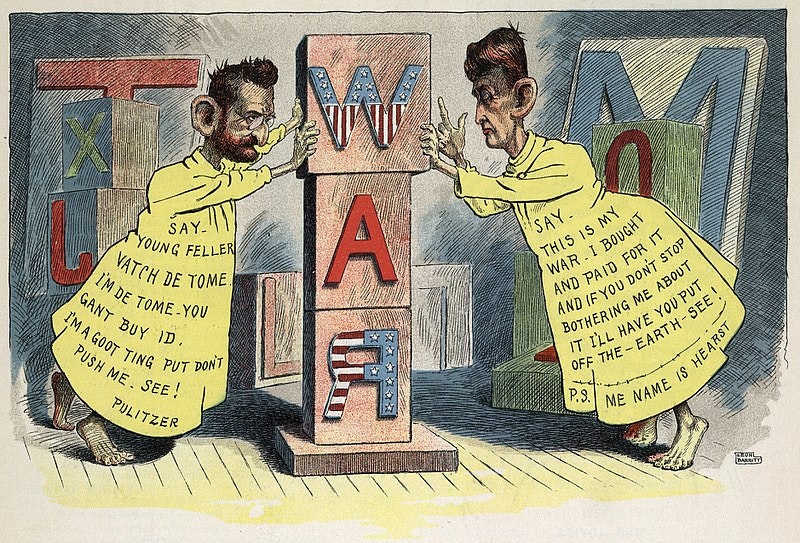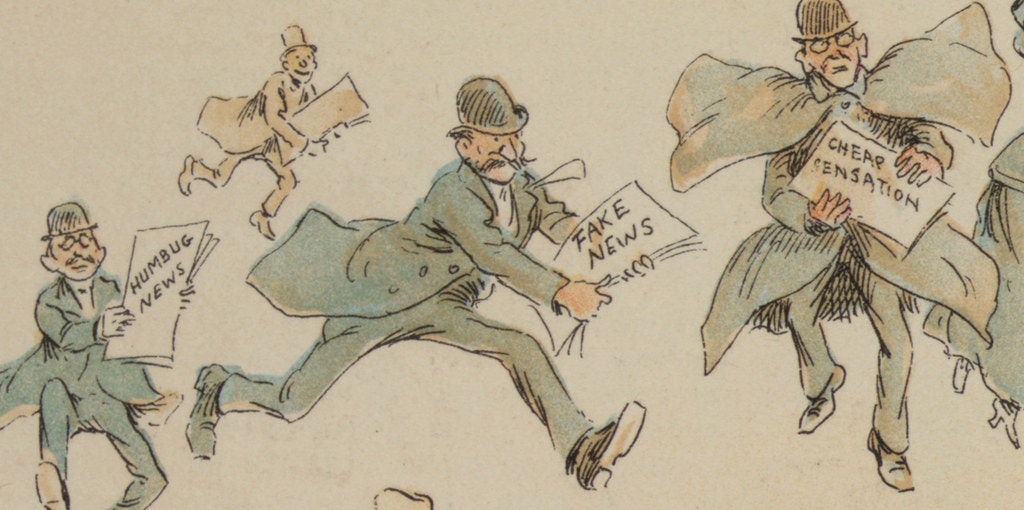
Yellow Journalism: The “Fake News” of the 19th Century
It is perhaps not so surprising to hear that the problem of "fake news" — media outlets adopting sensationalism to the point of fantasy — is nothing new. Although, as Robert Darnton explained in the NYRB recently, the peddling of public lies for political gain (or simply financial profit) can be found in most periods of history dating back to antiquity, it is in the late 19th-century phenomenon of "Yellow Journalism" that it first seems to reach the widespread outcry and fever pitch of scandal familiar today. Why yellow? The reasons are not totally clear. Some sources point to the yellow ink the publications would sometimes use, though it more likely stems from the popular Yellow Kid cartoon that first ran in Joseph Pulitzer's New York World, and later William Randolph Hearst's New York Journal, the two newspapers engaged in the circulation war at the heart of the furore.
Although these days his name is somewhat synonymous with journalism of the highest standards, through association with the Pulitzer Prize established by provisions in his will, Joseph Pulitzer had a very different reputation while alive. After purchasing The New York World in 1884 and rapidly increasing circulation through the publication of sensationalist stories he earned the dubious honour of being the pioneer of tabloid journalism. He soon had a competitor in the field when his rival William Randolph Hearst acquired the The New York Journal in 1885 (originally begun by Joseph's brother Albert). The rivalry was fierce, each trying to out do each other with ever more sensational and salacious stories. At a meeting of prominent journalists in 1889 Florida Daily Citizen editor Lorettus Metcalf claimed that due to their competition “the evil grew until publishers all over the country began to think that perhaps at heart the public might really prefer vulgarity”.
The phenomenon can be seen to reach its most rampant heights, and most exemplary period, in the lead up to the Spanish-American War — a conflict that some dubbed "The Journal's War" due to Hearst's immense influence in stoking the fires of anti-Spanish sentiment in the U.S. Much of the coverage by both The New York World and The New York Journal was tainted by unsubstantiated claims, sensationalist propaganda, and outright factual errors. When the USS Maine exploded and sank in Havana Harbor on the evening of 15 February 1898, huge headlines in the Journal blamed Spain with no evidence at all. The phrase, "remember the Maine, to Hell with Spain", became a populist rousing call to action. The Spanish–American War began later that year.
 Scroll through the whole page to download all images before printing.
Scroll through the whole page to download all images before printing.Editorial cartoon by Leon Barritt for June 1898 issue of Vim magazine, showing Joseph Pulitzer and William Randolph Hearst both attired as the Yellow Kid comics character and competitively claiming ownership of the war — Source.
As we've witnessed over recent weeks, from certain mouths the use of the term "fake news" has strayed from simply describing factually incorrect reporting. Likewise would those in power paste the label of "yellow journalism" on factually correct reporting which didn't quite paint the picture they'd like? Yes, indeed. As Timeline reports, in 1925 a certain Benito Mussolini derided reports of his ill health as being lies by the "yellow press", saying the papers were "ready to stop at nothing to increase circulation and to make more money". The reports, however, turned out to be factually accurate. He'd go onto rule the country for another eighteen years.
Featured below are a selection of illustrations from the wonderful Puck magazine commenting on the phenomenon, all found in the collection of the Library of Congress.
The Yellow Press, illustration from 1910 depicting William Randolph Hearst as a jester tossing newspapers with headlines such as 'Appeals to Passion, Venom, Sensationalism, Attacks on Honest Officials, Strife, Distorted News, Personal Grievance, [and] Misrepresentation' to a crowd of eager readers — Source.
The Lucrezia Borgia of Journalism (1910) — William Randolph Hearst, wearing a bright yellow dress, as Lucrezia Borgia painting poison from pots labeled 'Slander', 'Riot', 'Scandal', 'Malice', and 'Spite' on various newspapers scattered on the floor, where also sits a further tub labelled 'Attacks on Decent Officials'. The note to the bottom right explains: 'To poison the pages of a book, so that the mere handling of it might be fatal, was said to be a favorite method of the Borgias' — Source.
Uncle Sam's Dream of Conquest and Carnage - Caused by Reading the Jingo Newspapers (1895) — Source.
The 'New Journalism' Beats Him (1897) — Source.
Detail from Honor to McKinley! (1898), showing Pulitzer and Hearst, caricatured as a parrot and monkey respectively, battling it out amid a flurry of pages from the Yellow Press. The rest of the picture shows President McKinley below them ignoring their cries for war. Instead he reads a paper entitled 'The People of the United States have full confidence in your Patriotism, Integrity, & Bravery. They know you will act justly and wisely: decent press'. Such praise of McKinley's resistance to war would not last for long: a month later he asked Congress for authority to send American troops to Cuba — Source.
Atlas Joe; or, The Fearful Responsibilities of a Self-Appointed Manager of the Universe (1896), note the message hanging on the wall: 'Our Motto - Sensation! Sensation! Sensation!!' — Source.
The Fin de Siècle Newspaper Proprietor (1894), the central figure presumably Joseph Pulitzer — Source.
The Rape of Lucrece (1906) — Source.
The Sea-Serpent Season Upon us Again (1895) — Source.
Feb 21, 2017









